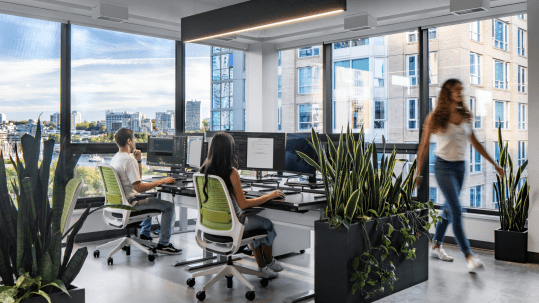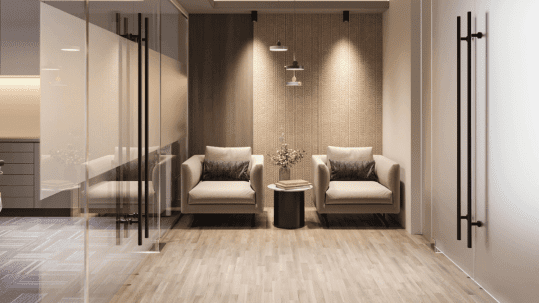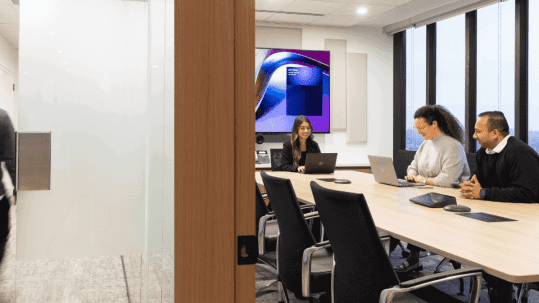Gone are the days when employees were expected to be in their seats for the whole workday. The COVID-19 pandemic showed us first-hand that almost all sectors can benefit from adopting hybrid working models. In fact, giving staff the option to work remotely while also giving them access to a physical office space is now becoming the standard for employers who want to remain competitive in a market that’s full of options for workers. But as organizations plan for their return to the office, it turns out that many still don’t have much of a plan for how it’s all going to work.
In recent research, we did in collaboration with Now of Work, only 30% of North American companies surveyed said they have a formal plan in place for adopting a hybrid working arrangement. So how can you plan accordingly? How can you make sure that your hybrid working model maximizes productivity, preserves company culture, and is sustainable for the long term? Here are some tips from our team of experts at AURA on how to successfully transition to a hybrid working model.
Take a data-driven approach to planning
The key to a successful transition to a hybrid working model is to take a scientific approach based on quantifiable information. Rather than making mere assumptions on how many meeting spaces, workstations, and offices you might need to support your workforce’s needs, you need to gather factual data and complex numbers.
Taking a data-driven approach to your planning involves gathering key organizational information at the very start of your process. We recommend undergoing a company-wide assessment that assesses every employee in terms of how they’re working now and how they want to be working in the future.
When working with our clients at AURA, we use Pivvot to conduct these assessments. The workforce planning tool simplifies this process by taking employee responses to a survey and categorizing them into one of a few personas. This ultimately helps leadership understand the complete makeup of their workforce and what needs attention to ensure that staff are most productive in their respective roles.
Gathering quantifiable information like this will help you make key decisions around the allocation of space, whether or not to renew a lease, and whether you need to downsize or expand your space. No more guessing.

Get both leadership alignment and staff involvement
To ensure that the transition to a hybrid working model is successful, you’ll need to start by getting alignment from key stakeholders and leadership on the future of work at your organization.
It’s important to take the time to host interviews with leadership and sit down to have in-depth discussions around how departments are currently working best and what environments are needed to sustain or accelerate their performance.
Interview department managers to find out:
- What does a day in the office currently look like for their team?
- Does the team require lots of collaboration?
- Does it typically meet in open or closed meeting rooms?
- Are all team members working remotely at any given time?
- Do in-person meetings speed up decision-making?
These interviews will help you understand the state of the organization and its appetite for change.
We also recommend involving all levels of staff in your planning process. While many planning aspects might come from the top-down, it’s wise to create a committee of staff at various levels of the organization to play a key role in showing your workforce how the hybrid model is going to work. Forming this committee gives staff a place to direct their questions, comments, and concerns as they adapt to a new way of working.
Continuously evaluate the needs of your employees
Adopting a hybrid working model isn’t about following a trend, but about delivering the desired experience for the hybrid worker. To make sure that what you’re offering is indeed what’s needed, you’ll have to continuously make efforts to understand what your staff need now and forecast their needs in the future. Failing to consider these needs and make calculated efforts to meet them will only result in your organization losing talent to your competition, who may do a better job.
To earn the loyalty of your workforce, you’ll need to listen carefully to their needs and then create suitable environments that meet them. By conducting an assessment and involving your staff in the process as we mentioned above, you might uncover that your staff:
- Value their work/life balance
- Want to be trusted with how they use their time
- Value physical and mental wellness more than they did before
- Seek ongoing flexibility with when and where they do their work
- Are eager to cut commute times and related expenses.
- Like the option of working in a range of spaces (e.g. for focus work vs for meetings)
- Want the option to come into the office as they see fit
- Want to continue to be engaged in corporate culture
Your next step will be to ensure that the office environment you provide best supports these needs.

Incorporate design elements that support hybrid working
Once you’ve uncovered your staff’s needs, you need to be sure that the work environments you offer accommodate these needs and provide appropriate levels of comfort.
This can look like redesigning the office environment to provide:
- More spaces for individual work, support, and socialization
- Appropriately spaced workstations (6 feet apart)
- Removable workstation panel extensions
- Workstations that provide visual and acoustic privacy
- Glass separators that provide a sense of security and separation
- Private virtual rooms/solo meeting rooms complete with adequate lighting, connectivity for all employees and guests, and ergonomic furniture
- More regimented cleaning systems and frequency of cleaning
It can also look like making sure your workforce is set up to do their job from home by providing them with home office stipends like ergonomic chairs, desks, and high-speed internet. The goal is to make sure that no matter what role they’re in or where they work, they always have the resources they need in place to support them.
Leading organizations are adopting desk booking (or hotelling) software that allows your staff to book their desk in the office ahead of time. The use of these apps not only helps your employees decide when they’d like to be in the office (is it too busy for me today? Is the rest of my team in? Where are they sitting?), but also works as a handy tool for helping you determine capacity limits for safety on any given day.
Account for flexibility and company growth
Last but not least, when strategizing for a hybrid working model, you want to make sure you’re considering multiple scenarios like:
- How will the organization work if we get hit with another pandemic?
- What if we double or triple in size in the next 5, 10, or 15 years?
- How much office space will we need if more employees go fully remote?
To get the answers to these possibilities and make decisions regarding space and design, you can make use of the data and modelling that comes out of your company-wide assessment. We use Pivvot’s scenario planning feature with our client to consider multiple scenarios the company may face in the future and help them understand potential impacts to productivity, profitability, savings and expenditures.
Transitioning to a hybrid working model involves considerable planning, a deep understanding of your workforce, and the gathering of factual data to best guide your decisions. Whether you are approaching the time to renew your lease or not, it’s never too early to start planning for your organization’s future by getting the ball rolling on your company assessment.






